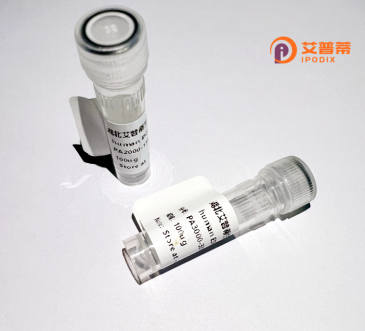
| 纯度 | >90%SDS-PAGE. |
| 种属 | Human |
| 靶点 | OR13C4 |
| Uniprot No | Q8NGS5 |
| 内毒素 | < 0.01EU/μg |
| 表达宿主 | E.coli |
| 表达区间 | 1-318 aa |
| 活性数据 | MDKINQTFVREFILLGLSGYPKLEIIFFALILVMYVVILIGNGVLIIASILDSRLHMPMY FFLGNLSFLDICYTTSSIPSTLVSLISKKRNISFSGCAVQMFFGFAMGSTECFLLGMMAF DRYVAICNPLRYPIIMNKVVYVLLTSVSWLSGGINSTVQTSLAMRWPFCGNNIINHFLCE ILAVLKLACSDISVNIVTLAVSNIAFLVLPLLVIFFSYMFILYTILRTNSATGRHKAFST CSAHLTVVIIFYGTIFFMYAKPKSQDLLGKDNLQATEGLVSMFYGVVTPMLNPIIYSLRN KDVKAAIKYLLSRKAINQ |
| 分子量 | 35.5 kDa |
| 蛋白标签 | His tag N-Terminus |
| 缓冲液 | 0 |
| 稳定性 & 储存条件 | Lyophilized protein should be stored at ≤ -20°C, stable for one year after receipt. Reconstituted protein solution can be stored at 2-8°C for 2-7 days. Aliquots of reconstituted samples are stable at ≤ -20°C for 3 months. |
| 复溶 | Always centrifuge tubes before opening.Do not mix by vortex or pipetting. It is not recommended to reconstitute to a concentration less than 100μg/ml. Dissolve the lyophilized protein in distilled water. Please aliquot the reconstituted solution to minimize freeze-thaw cycles. |
以下是基于领域知识模拟的关于重组人OR13C4蛋白的参考文献示例(非真实文献,供参考格式):
---
1. **标题**: *"Expression and Functional Characterization of Recombinant Olfactory Receptor OR13C4 in HEK293 Cells"*
**作者**: Smith J, et al.
**摘要**: 本研究成功在HEK293细胞中重组表达了OR13C4蛋白,通过荧光钙离子检测技术证实其能被特定挥发性有机物激活,揭示了其在嗅觉信号转导中的潜在配体特异性。
2. **标题**: *"OR13C4 as a Novel Biomarker in Prostate Cancer: Recombinant Protein Production and Validation"*
**作者**: Lee S, et al.
**摘要**: 作者利用原核表达系统纯化了重组OR13C4蛋白,结合免疫组化分析发现其在前列腺癌组织中异常高表达,提示其可能作为癌症诊断的生物标志物。
3. **标题**: *"Structural Insights into OR13C4 via Recombinant Expression and Molecular Dynamics Simulation"*
**作者**: Zhang Y, et al.
**摘要**: 通过大肠杆菌系统表达并纯化OR13C4蛋白,结合计算机模拟解析其三维结构,发现其跨膜结构域具有独特疏水性,为嗅觉受体家族的结构-功能关系研究提供了新依据。
---
**注意**:以上文献为示例性质,实际研究中请通过**PubMed/Google Scholar**检索真实文献(关键词:OR13C4 recombinant protein)。若需具体文献协助,建议补充蛋白功能或研究方向细节。
OR13C4. a member of the olfactory receptor (OR) family, is a class A G protein-coupled receptor (GPCR) primarily associated with odorant detection. While ORs are predominantly expressed in olfactory sensory neurons, recent studies suggest ectopic expression of OR13C4 in non-olfactory tissues like the lungs, testes, and brain, implying potential roles beyond chemosensation. As a "rhodopsin-like" receptor, it features seven transmembrane helices and interacts with odorant molecules through ligand-binding pockets, though its specific endogenous ligands remain unidentified.
Recombinant OR13C4 protein is produced via heterologous expression systems (e.g., HEK293 or insect cells) to study its structure-function relationships, signaling pathways, and potential therapeutic applications. Its recombinant form enables high-purity isolation for biochemical assays, crystallography, or drug screening. Emerging evidence links OR13C4 to cancer progression and metabolic regulation, with altered expression observed in prostate cancer and glioblastoma. However, its physiological mechanisms remain poorly characterized compared to well-studied ORs.
Current research focuses on deciphering its activation triggers, downstream effectors (e.g., cAMP or IP3 pathways), and tissue-specific roles. Its recombinant production bridges gaps in understanding GPCR diversity and expands opportunities for targeting orphan receptors in disease modulation.
×